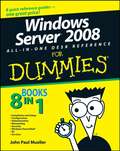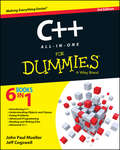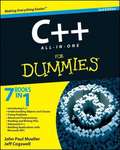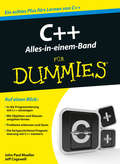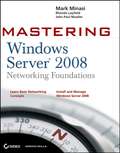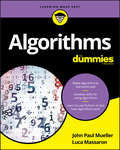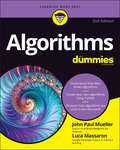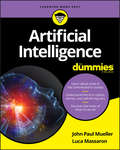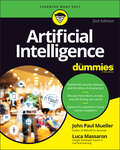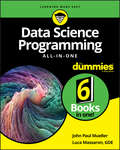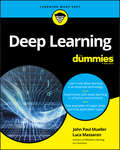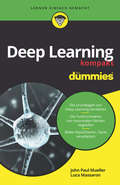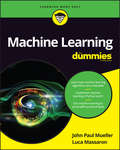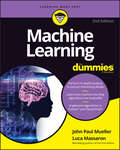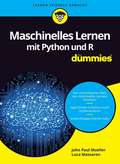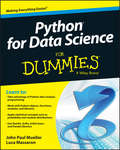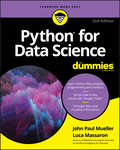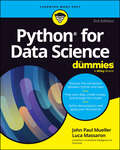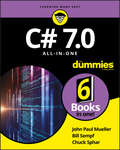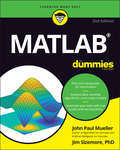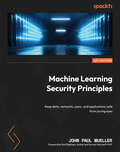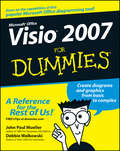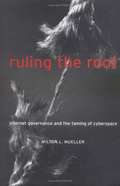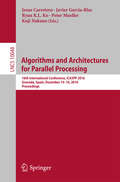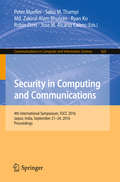- Table View
- List View
Windows Server 2008 All-In-One Desk Reference For Dummies
by John Paul MuellerIf you've been waiting impatiently for the arrival of Windows Server 2008, wait no more! It's here, and so is Windows Server 2008 All-In-One Desk Reference For Dummies to help you install it, configure it, network with it, secure it, command it with Windows PowerShell, and more. Services best practices and the cool IIS Web server are covered too.The eight powerful quick-reference manuals in this one-stop guide cover all the information you need to perform common administrative tasks with Windows Server 2008. You'll find sure-handed guidance and considerable detail on everything from installation to figuring out why a user can't gain access to resources on the server. You also see procedures for all common tasks -- everything from setting up Internet Connection Sharing (ICS) to promoting your server to a domain controller. Discover how to:Use Windows Server virtualizationPerform a complete PC restoreConfigure server roles and featuresMeasure system performanceAdd network clients and protocolsKeep your server operating at peak performanceMonitor network interactions with othersWork with Active Directory RMSUse best practices for implementing securityImplement scripts and cmdlets with PowerShellUncloak viruses masquerading as servicesWindows Server 2008 contains so many features that it's sometimes hard to know which one to install. No problem! Just flip open Windows Server 2008 All-In-One Desk Reference For Dummies and find your answer in a flash!
C++ All-in-One For Dummies
by John Paul Mueller Jeff CogswellGet ahead of the C++ curve to stay in the game C++ is the workhorse of programming languages and remains one ofthe most widely used programming languages today. It'scross-platform, multi-functional, and updates are typicallyopen-source. The language itself is object-oriented, offering youthe utmost control over data usage, interface, and resourceallocation. If your job involves data, C++ proficiency makes youindispensable.C++ All-in-One For Dummies, 3rd Edition is yournumber-one handbook to C++ mastery. Author John Paul Mueller is arecognized authority in the computer industry, and your ultimateguide to C++. Mueller takes you through all things C++, includinginformation relevant to the 2014 update.Learn how to work with objects and classesConquer advanced programming and troubleshootingDiscover how lambda expressions can make your code more conciseand readableSee Standard Library features, such as dynamic arrays, inactionOnline resources include source code from examples in the bookas well as a C++ GNU compiler. If you need to learn C++, this isthe fastest, most effective way to do it. C++ All-in-One ForDummies, 3rd Edition will get you up and running quickly, soyou can get to work producing code faster and better than ever.
C++ All-in-One For Dummies, 2nd Edition
by John Paul Mueller Jeff CogswellHere's the easy way to learn how to use C++ C++, developed by Bjarne Stroustrup at Bell Labs, is one of the most widely used programming languages, with close to four million C++ programmers and growing. C++'s popularity has earned it a spot as part of the Standard Library. Fully updated for the new C++ 2009 standard, C++ All-in-One for Dummies, 2nd Edition compiles seven books into one. This guidebook covers key topics like an introduction to C++, understanding objects and classes, fixing problems, advanced programming, reading and writing files, advanced C++, and building applications with Microsoft MFC. If you're a C++ newbie, start with Book I. But if you're experienced with C++, simply jump in anywhere to learn more! This all-in-one reference helps you learn to: Use C++ for Windows, Mac, and Linux by using the CodeBlocks compiler Understand object-oriented programming Use various diagrams to design your programs Recognize how local variables are stored Use packages, notes, and tags effectively Make a class persistent Handle constructors and destructors With over 25,000 sold of the previous bestselling edition, this second edition with a bonus CD makes C++ easier to understand. It's a perfect introduction for new programmers and guide for advanced programmers. Note: CD-ROM/DVD and other supplementary materials are not included as part of eBook file.
C++ Alles in einem Band für Dummies (Für Dummies)
by John Paul Mueller Jeffrey M. CogswellDieses Buch ist für alle, die tief in die C++-Programmierung einsteigen möchten. Dennoch werden keine Programmierkenntnisse vorausgesetzt. John Paul Mueller und Jeff Cogswell erklären Ihnen zunächst, wie Sie C++ installieren. Sie erfahren, was Klassen und Objekte sind, was Sie mit Entwurfsmustern anfangen und wie Sie Ihre Programme debuggen. Aus Anfängern werden Entwickler mit Erfahrung und dann fortgeschrittene Programmierer. Diese finden in diesem Buch Informationen zu dynamischen Arrays, Lambda-Ausdrücken, Streams, UML, der Standardbibliothek, zu Boost und vielem mehr. Alle Codebeispiele des Buchs stehen zum Download zur Verfügung.
Mastering Windows Server 2008 Networking Foundations
by John Paul Mueller Rhonda Layfield Mark MinasiFind in-depth coverage of general networking concepts and basic instruction on Windows Server 2008 installation and management including active directory, DNS, Windows storage, and TCP/IP and IPv4 networking basics in Mastering Windows Server 2008 Networking Foundations. One of three new books by best-selling author Mark Minasi, this guide explains what servers do, how basic networking works (IP basics and DNS/WINS basics), and the fundamentals of the under-the-hood technologies that support staff must understand. Learn how to install Windows Server 2008 and build a simple network, security concepts, and basic Windows Server administration.
Algorithms For Dummies
by John Paul Mueller Luca MassaronDiscover how algorithms shape and impact our digital world All data, big or small, starts with algorithms. Algorithms are mathematical equations that determine what we see—based on our likes, dislikes, queries, views, interests, relationships, and more—online. They are, in a sense, the electronic gatekeepers to our digital, as well as our physical, world. This book demystifies the subject of algorithms so you can understand how important they are business and scientific decision making. Algorithms for Dummies is a clear and concise primer for everyday people who are interested in algorithms and how they impact our digital lives. Based on the fact that we already live in a world where algorithms are behind most of the technology we use, this book offers eye-opening information on the pervasiveness and importance of this mathematical science—how it plays out in our everyday digestion of news and entertainment, as well as in its influence on our social interactions and consumerism. Readers even learn how to program an algorithm using Python! Become well-versed in the major areas comprising algorithms Examine the incredible history behind algorithms Get familiar with real-world applications of problem-solving procedures Experience hands-on development of an algorithm from start to finish with Python If you have a nagging curiosity about why an ad for that hammock you checked out on Amazon is appearing on your Facebook page, you'll find Algorithm for Dummies to be an enlightening introduction to this integral realm of math, science, and business.
Algorithms For Dummies
by John Paul Mueller Luca MassaronYour secret weapon to understanding—and using!—one of the most powerful influences in the world today From your Facebook News Feed to your most recent insurance premiums—even making toast!—algorithms play a role in virtually everything that happens in modern society and in your personal life. And while they can seem complicated from a distance, the reality is that, with a little help, anyone can understand—and even use—these powerful problem-solving tools! In Algorithms For Dummies, you'll discover the basics of algorithms, including what they are, how they work, where you can find them (spoiler alert: everywhere!), who invented the most important ones in use today (a Greek philosopher is involved), and how to create them yourself. You'll also find: Dozens of graphs and charts that help you understand the inner workings of algorithms Links to an online repository called GitHub for constant access to updated code Step-by-step instructions on how to use Google Colaboratory, a zero-setup coding environment that runs right from your browser Whether you're a curious internet user wondering how Google seems to always know the right answer to your question or a beginning computer science student looking for a head start on your next class, Algorithms For Dummies is the can't-miss resource you've been waiting for.
Artificial Intelligence For Dummies
by John Paul Mueller Luca MassaronStep into the future with AI The term "Artificial Intelligence" has been around since the 1950s, but a lot has changed since then. Today, AI is referenced in the news, books, movies, and TV shows, and the exact definition is often misinterpreted. Artificial Intelligence For Dummies provides a clear introduction to AI and how it’s being used today. Inside, you’ll get a clear overview of the technology, the common misconceptions surrounding it, and a fascinating look at its applications in everything from self-driving cars and drones to its contributions in the medical field. Learn about what AI has contributed to society Explore uses for AI in computer applications Discover the limits of what AI can do Find out about the history of AI The world of AI is fascinating—and this hands-on guide makes it more accessible than ever!
Artificial Intelligence For Dummies
by John Paul Mueller Luca MassaronForget far-away dreams of the future. Artificial intelligence is here now! Every time you use a smart device or some sort of slick technology—be it a smartwatch, smart speaker, security alarm, or even customer service chat box—you’re engaging with artificial intelligence (AI). If you’re curious about how AI is developed—or question whether AI is real—Artificial Intelligence For Dummies holds the answers you’re looking for. Starting with a basic definition of AI and explanations of data use, algorithms, special hardware, and more, this reference simplifies this complex topic for anyone who wants to understand what operates the devices we can’t live without. This book will help you: Separate the reality of artificial intelligence from the hype Know what artificial intelligence can accomplish and what its limits are Understand how AI speeds up data gathering and analysis to help you make informed decisions more quickly See how AI is being used in hardware applications like drones, robots, and vehicles Know where AI could be used in space, medicine, and communication fields sooner than you think Almost 80 percent of the devices you interact with every day depend on some sort of AI. And although you don’t need to understand AI to operate your smart speaker or interact with a bot, you’ll feel a little smarter—dare we say more intelligent—when you know what’s going on behind the scenes. So don’t wait. Pick up this popular guide to unlock the secrets of AI today!
Data Science Programming All-In-One For Dummies
by John Paul Mueller Luca MassaronYour logical, linear guide to the fundamentals of data science programming Data science is exploding—in a good way—with a forecast of 1.7 megabytes of new information created every second for each human being on the planet by 2020 and 11.5 million job openings by 2026. It clearly pays dividends to be in the know. This friendly guide charts a path through the fundamentals of data science and then delves into the actual work: linear regression, logical regression, machine learning, neural networks, recommender engines, and cross-validation of models. Data Science Programming All-In-One For Dummies is a compilation of the key data science, machine learning, and deep learning programming languages: Python and R. It helps you decide which programming languages are best for specific data science needs. It also gives you the guidelines to build your own projects to solve problems in real time. Get grounded: the ideal start for new data professionals What lies ahead: learn about specific areas that data is transforming Be meaningful: find out how to tell your data story See clearly: pick up the art of visualization Whether you’re a beginning student or already mid-career, get your copy now and add even more meaning to your life—and everyone else’s!
Deep Learning For Dummies
by John Paul Mueller Luca MassaronTake a deep dive into deep learning Deep learning provides the means for discerning patterns in the data that drive online business and social media outlets. Deep Learning for Dummies gives you the information you need to take the mystery out of the topic—and all of the underlying technologies associated with it. In no time, you’ll make sense of those increasingly confusing algorithms, and find a simple and safe environment to experiment with deep learning. The book develops a sense of precisely what deep learning can do at a high level and then provides examples of the major deep learning application types. Includes sample code Provides real-world examples within the approachable text Offers hands-on activities to make learning easier Shows you how to use Deep Learning more effectively with the right tools This book is perfect for those who want to better understand the basis of the underlying technologies that we use each and every day.
Deep Learning kompakt für Dummies (Für Dummies)
by John Paul Mueller Luca MassaronWollen Sie sich über Deep Learning informieren und vielleicht erste kleine Schritte machen, diese Technologie zu nutzen? Dann hilft Ihnen dieses Buch. Die Autoren erklären Ihnen, welchen Einfluss Deep Learning im Alltag hat und in welcher Beziehung es zu maschinellem Lernen steht. Sie sammeln erste eigene Erfahrungen mit vorgegebenen Python-Programmen und verstehen so die Funktionsweise von neuronalen Netzen und wie Bilder klassifiziert und Sprache sowie Text verarbeitet werden. So ist dieses Buch ein schneller erster und verständlicher Einstieg in Deep Learning.
Machine Learning For Dummies
by John Paul Mueller Luca MassaronYour no-nonsense guide to making sense of machine learning Machine learning can be a mind-boggling concept for the masses, but those who are in the trenches of computer programming know just how invaluable it is. Without machine learning, fraud detection, web search results, real-time ads on web pages, credit scoring, automation, and email spam filtering wouldn't be possible, and this is only showcasing just a few of its capabilities. Written by two data science experts, Machine Learning For Dummies offers a much-needed entry point for anyone looking to use machine learning to accomplish practical tasks. Covering the entry-level topics needed to get you familiar with the basic concepts of machine learning, this guide quickly helps you make sense of the programming languages and tools you need to turn machine learning-based tasks into a reality. Whether you're maddened by the math behind machine learning, apprehensive about AI, perplexed by preprocessing data--or anything in between--this guide makes it easier to understand and implement machine learning seamlessly. Grasp how day-to-day activities are powered by machine learning Learn to 'speak' certain languages, such as Python and R, to teach machines to perform pattern-oriented tasks and data analysis Learn to code in R using R Studio Find out how to code in Python using Anaconda Dive into this complete beginner's guide so you are armed with all you need to know about machine learning!
Machine Learning For Dummies
by John Paul Mueller Luca MassaronYour comprehensive entry-level guide to machine learning While machine learning expertise doesn’t quite mean you can create your own Turing Test-proof android—as in the movie Ex Machina—it is a form of artificial intelligence and one of the most exciting technological means of identifying opportunities and solving problems fast and on a large scale. Anyone who masters the principles of machine learning is mastering a big part of our tech future and opening up incredible new directions in careers that include fraud detection, optimizing search results, serving real-time ads, credit- scoring, building accurate and sophisticated pricing models—and way, way more. Unlike most machine learning books, the fully updated 2nd Edition of Machine Learning For Dummies doesn’t assume you have years of experience using programming languages such as Python (R source is also included in a downloadable form with comments and explanations), but lets you in on the ground floor, covering the entry-level materials that will get you up and running building models you need to perform practical tasks. It takes a look at the underlying—and fascinating—math principles that power machine learning but also shows that you don’t need to be a math whiz to build fun new tools and apply them to your work and study. Understand the history of AI and machine learning Work with Python 3.8 and TensorFlow 2.x (and R as a download) Build and test your own models Use the latest datasets, rather than the worn out data found in other books Apply machine learning to real problems Whether you want to learn for college or to enhance your business or career performance, this friendly beginner’s guide is your best introduction to machine learning, allowing you to become quickly confident using this amazing and fast-developing technology that’s impacting lives for the better all over the world.
Maschinelles Lernen mit Python und R für Dummies (Für Dummies)
by John Paul Mueller Luca MassaronMaschinelles Lernen ist aufregend: Mit schnellen Prozessoren und großen Speichern können Computer aus Erfahrungen lernen, künstliche Intelligenz kommt wieder in Reichweite. Mit diesem Buch verstehen Sie, was maschinelles Lernen bedeutet, für welche Probleme es sich eignet, welche neuen Herangehensweisen damit möglich sind und wie Sie mit Python, R und speziellen Werkzeugen maschinelles Lernen implementieren. Sie brauchen dafür keine jahrelange Erfahrung als Programmierer und kein Mathematikstudium. Die praktische Anwendung maschinellen Lernens steht in diesem Buch im Vordergrund. Spielen Sie mit den Tools und haben Sie Spaß dabei! Lernen Sie Fakten und Mythen zum maschinellen Lernen zu unterscheiden.
Python for Data Science For Dummies
by John Paul Mueller Luca Massaronof the most widely-used libraries, including NumPy, SciPy, BeautifulSoup, Pandas, and MatPlobLibWhether you're new to data analysis or just new to Python, Python for Data Science For Dummies is your practical guide to getting a grip on data overload and doing interesting things with the oodles of information you uncover.
Python for Data Science For Dummies
by John Paul Mueller Luca MassaronThe fast and easy way to learn Python programming and statistics Python is a general-purpose programming language created in the late 1980s—and named after Monty Python—that's used by thousands of people to do things from testing microchips at Intel, to powering Instagram, to building video games with the PyGame library. Python For Data Science For Dummies is written for people who are new to data analysis, and discusses the basics of Python data analysis programming and statistics. The book also discusses Google Colab, which makes it possible to write Python code in the cloud. Get started with data science and Python Visualize information Wrangle data Learn from data The book provides the statistical background needed to get started in data science programming, including probability, random distributions, hypothesis testing, confidence intervals, and building regression models for prediction.
Python for Data Science For Dummies
by John Paul Mueller Luca MassaronLet Python do the heavy lifting for you as you analyze large datasets Python for Data Science For Dummies lets you get your hands dirty with data using one of the top programming languages. This beginner’s guide takes you step by step through getting started, performing data analysis, understanding datasets and example code, working with Google Colab, sampling data, and beyond. Coding your data analysis tasks will make your life easier, make you more in-demand as an employee, and open the door to valuable knowledge and insights. This new edition is updated for the latest version of Python and includes current, relevant data examples. Get a firm background in the basics of Python coding for data analysis Learn about data science careers you can pursue with Python coding skills Integrate data analysis with multimedia and graphics Manage and organize data with cloud-based relational databasesPython careers are on the rise. Grab this user-friendly Dummies guide and gain the programming skills you need to become a data pro.
C# 7.0 All-in-One For Dummies
by John Paul Mueller Bill Sempf Chuck SpharSharpen your knowledge of C# C# know-how is a must if you want to be a professional Microsoft developer. It's also good to know a little C# if you're building tools for the web, mobile apps, or other development tasks. C# 7.0 All-in-One For Dummies offers a deep dive into C# for coders still learning the nuances of the valuable programming language. Pop it open to get an intro into coding with C#, how to design secure apps and databases, and even pointers on building web and mobile apps with C#. C# remains one of the most in-demand programming language skills. The language regularly ranks in the top five among "most in-demand" languages, typically along with Java/JavaScript, C++, and Python. A December 2016 ZDNet article noted 'If your employer is a Microsoft developer, you better know C#." Lucky for you, this approachable, all-in-one guide is here to help you do just that—without ever breaking a sweat! Includes coverage of the latest changes to C# Shows you exactly what the language can (and can't) do Presents familiar tasks that you can accomplish with C# Provides insight into developing applications that provide protection against hackers If you have a basic understanding of coding and need to learn C#—or need a reference on the language in order to launch or further your career—look no further.
MATLAB For Dummies
by John Paul Mueller Jim SizemoreGo from total MATLAB newbie to plotting graphs and solving equations in a flash! MATLAB is one of the most powerful and commonly used tools in the STEM field. But did you know it doesn’t take an advanced degree or a ton of computer experience to learn it? MATLAB For Dummies is the roadmap you’ve been looking for to simplify and explain this feature-filled tool. This handy reference walks you through every step of the way as you learn the MATLAB language and environment inside-and-out. Starting with straightforward basics before moving on to more advanced material like Live Functions and Live Scripts, this easy-to-read guide shows you how to make your way around MATLAB with screenshots and newly updated procedures. It includes: A comprehensive introduction to installing MATLAB, using its interface, and creating and saving your first file Fully updated to include the 2020 and 2021 updates to MATLAB, with all-new screenshots and up-to-date procedures Enhanced debugging procedures and use of the Symbolic Math Toolbox Brand new instruction on working with Live Scripts and Live Functions, designing classes, creating apps, and building projects Intuitive walkthroughs for MATLAB’s advanced features, including importing and exporting data and publishing your work Perfect for STEM students and new professionals ready to master one of the most powerful tools in the fields of engineering, mathematics, and computing, MATLAB For Dummies is the simplest way to go from complete newbie to power user faster than you would have thought possible.
Machine Learning Security Principles: Keep data, networks, users, and applications safe from prying eyes
by John Paul Mueller Rod Stephens Alberto Di MeglioThwart hackers by preventing, detecting, and misdirecting access before they can plant malware, obtain credentials, engage in fraud, modify data, poison models, corrupt users, eavesdrop, and otherwise ruin your dayKey FeaturesDiscover how hackers rely on misdirection and deep fakes to fool even the best security systemsRetain the usefulness of your data by detecting unwanted and invalid modificationsDevelop application code to meet the security requirements related to machine learningBook DescriptionBusinesses are leveraging the power of AI to make undertakings that used to be complicated and pricy much easier, faster, and cheaper. The first part of this book will explore these processes in more depth, which will help you in understanding the role security plays in machine learning.As you progress to the second part, you'll learn more about the environments where ML is commonly used and dive into the security threats that plague them using code, graphics, and real-world references.The next part of the book will guide you through the process of detecting hacker behaviors in the modern computing environment, where fraud takes many forms in ML, from gaining sales through fake reviews to destroying an adversary's reputation. Once you've understood hacker goals and detection techniques, you'll learn about the ramifications of deep fakes, followed by mitigation strategies.This book also takes you through best practices for embracing ethical data sourcing, which reduces the security risk associated with data. You'll see how the simple act of removing personally identifiable information (PII) from a dataset lowers the risk of social engineering attacks.By the end of this machine learning book, you'll have an increased awareness of the various attacks and the techniques to secure your ML systems effectively.What you will learnExplore methods to detect and prevent illegal access to your systemImplement detection techniques when access does occurEmploy machine learning techniques to determine motivationsMitigate hacker access once security is breachedPerform statistical measurement and behavior analysisRepair damage to your data and applicationsUse ethical data collection methods to reduce security risksWho this book is forWhether you're a data scientist, researcher, or manager working with machine learning techniques in any aspect, this security book is a must-have. While most resources available on this topic are written in a language more suitable for experts, this guide presents security in an easy-to-understand way, employing a host of diagrams to explain concepts to visual learners. While familiarity with machine learning concepts is assumed, knowledge of Python and programming in general will be useful.
Visio 2007 For Dummies
by John Paul Mueller Debbie WalkowskiReveal your inner business artist with VisioTurn your ideas into diagrams and drawings with Visio's stencils and templatesIf you have an idea you want to get down on electronic paper, Visio 2007 is for you, and so is this book! They're both flexible and user-friendly. Here's how to use Visio to capture ideas from simple to intricate, update data in a drawing with a single click, add and manipulate text, work with connectors, and more.Discover how toCreate business, engineering, software, or network diagramsFormat an entire drawing using themesAnalyze "what-if" scenarios with PivotDiagramsProduce layered multipage drawingsSave drawings to publish on the Web
Ruling the Root: Internet Governance and the Taming of Cyberspace
by Milton L. MuellerIn Ruling the Root, Milton Mueller uses the theoretical framework of institutional economics to analyze the global policy and governance problems created by the assignment of Internet domain names and addresses.
Algorithms and Architectures for Parallel Processing: 16th International Conference, ICA3PP 2016, Granada, Spain, December 14-16, 2016, Proceedings (Lecture Notes in Computer Science #10048)
by Peter Mueller Jesus Carretero Javier Garcia-Blas Ryan K.L. Ko Koji NakanoThis book constitutes the refereed proceedings of the 16th International Conference on Algorithms and Architectures for Parallel Processing, ICA3PP 2016, held in Granada, Spain, in December 2016. The 30 full papers and 22 short papers presented were carefully reviewed and selected from 117 submissions. They cover many dimensions of parallel algorithms and architectures, encompassing fundamental theoretical approaches, practical experimental projects, and commercial components and systems trying to push beyond the limits of existing technologies, including experimental efforts, innovative systems, and investigations that identify weaknesses in existing parallel processing technology.
Security in Computing and Communications
by Peter Mueller Sabu M. Thampi Md Zakirul Alam Bhuiyan Ryan Ko Robin Doss Jose M. Alcaraz CaleroThis book constitutes the refereed proceedings of the International Symposium on Security in Computing and Communications, SSCC 2013, held in Mysore, India, in August 2013. The 24 revised full papers presented together with 15 poster papers were carefully reviewed and selected from 111 submissions. The papers cover all aspects of secure computing and communication in networking and distributed systems such as cloud-based data centers.
